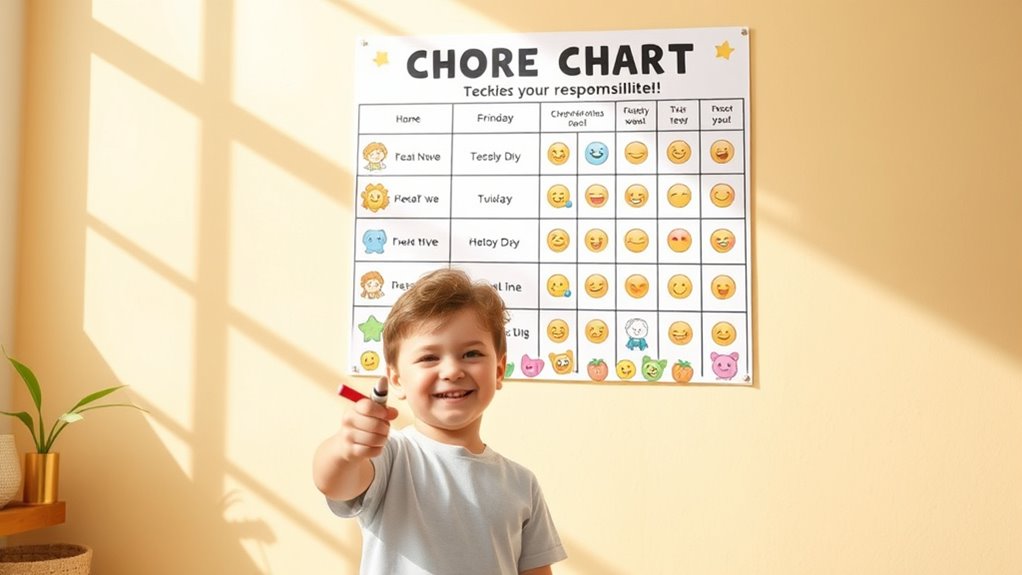To make chore charts that actually work, focus on creating colorful, visually appealing designs with stickers or images that represent each task. Incorporate immediate rewards like stars or points to motivate your kids and make chores feel like a fun game. Let them personalize their charts to boost ownership and celebrate small victories to build confidence. Keep routines consistent and rewards attainable—these tactics will turn responsibilities into engaging experiences, and you’ll find more helpful tips ahead.
Key Takeaways
- Use colorful, visually appealing charts with stickers and images to make chores engaging and fun for kids.
- Keep charts simple, with clear progress indicators, so children can easily see their achievements.
- Incorporate immediate rewards like stars or points to reinforce positive behavior and build motivation.
- Allow kids to personalize their chore charts, fostering ownership and pride in their responsibilities.
- Turn chores into routines with consistent, attainable rewards to maintain motivation and establish responsibility.

Have you ever wondered how to motivate your kids to complete their household tasks? One effective way is to implement reward systems that encourage responsibility while keeping things fun. Reward systems work best when they provide immediate positive reinforcement, so your kids feel recognized for their efforts. Visual trackers, like colorful charts or stickers, make these reward systems even more engaging. When your children see their progress clearly laid out, it becomes easier for them to understand what’s expected and feel proud of their accomplishments. These visual trackers serve as a constant reminder of their responsibilities and can turn chores into a game, rather than a chore. Incorporating elements from Free Floating design can help make chore charts feel more dynamic and less rigid, increasing engagement.
Reward systems with visual trackers make chores fun and help kids feel proud of their progress.
Start by creating a chore chart that’s simple and visually appealing. Use bright colors and images to represent different tasks—like a broom for sweeping or a plate for setting the table. Incorporate a reward system that pairs specific chores with immediate rewards, such as stickers, stars, or points. When your kids complete a task, they get to add a sticker or star to their visual tracker. Once they reach a certain number of stickers, they earn a predetermined reward, like extra screen time, a small toy, or a special treat. This immediate reinforcement helps reinforce good habits and keeps your children motivated. The key is to keep the rewards attainable and consistent so they don’t feel discouraged if they don’t reach a goal right away.
Make sure your visual trackers are easy to understand. For example, use a chart divided into days of the week or a grid that tracks progress over time. Let your kids personalize their charts with stickers or drawings—this makes the process more engaging and gives them a sense of ownership. As they see their progress, they’ll feel a sense of achievement, which boosts their motivation to keep up with chores. Remember to celebrate their successes, no matter how small. Complimenting their effort and progress reinforces positive behavior and encourages them to stay committed.
Finally, keep in mind that consistency is essential. Use the same reward system and visual trackers daily or weekly, so your kids know what to expect. Over time, chores become part of their routine, and the motivation to earn rewards becomes internalized. When you combine reward systems with colorful visual trackers, you turn chores into a fun challenge rather than a drudgery. Your kids will learn responsibility while feeling proud of their accomplishments—making household chores a positive, engaging experience for everyone involved.
Frequently Asked Questions
How Can I Customize Chore Charts for Different Age Groups?
You can customize chore charts for different age groups by including age-appropriate tasks that match their abilities. Use visual aids like pictures or color coding to make tasks clear and engaging. For younger kids, simplify chores and add fun visuals. Older kids can handle more responsibility with detailed lists. Adjust the complexity so each child feels challenged but successful, making responsibility a positive experience for everyone.
What Are Creative Rewards to Motivate Kids Beyond Stickers?
Think of creative incentive ideas as treasure chests waiting to be opened. Instead of relying on stickers, you can offer non-sticker rewards like extra screen time, a special outing, or a new book. These rewards act as bright stars guiding your child’s motivation. By offering meaningful, fun incentives, you turn chores into exciting adventures, encouraging your kids to take responsibility with enthusiasm and joy.
How Often Should Chores Be Updated or Changed?
You should update or change chores based on your child’s age, progress, and seasonal needs. Typically, consider adjusting chores every few months to prevent boredom and maintain motivation. Regularly reviewing your chore frequency and updating schedules keeps responsibilities fresh and engaging. This approach helps kids stay responsible, learn new skills, and feel accomplished. Remember, flexible schedules adapt better to your child’s development and your family’s evolving routine.
How Do I Handle Resistance or Refusal to Do Chores?
When your child resists chores, practice parental empathy by understanding their feelings, and use clear communication to address concerns. Calmly explain why chores are important and listen to their reasons for refusing. Offer encouragement and involve them in creating a routine, making chores feel less like a punishment. Consistency helps, and showing empathy fosters cooperation, making chores a team effort rather than a battle.
What Are Tips for Maintaining Consistency With Chore Routines?
Consistency feels like a tall mountain, but with the right motivational strategies, you can reach the summit. Keep your chore chart design simple and clear, making it easy for your kids to follow daily routines. Reinforce routines with positive feedback and set realistic expectations. By sticking to a routine and celebrating small wins, you’ll foster responsibility while making chores feel less like a chore and more like a habit.
Conclusion
By turning chores into a game, you’re planting seeds of responsibility that will blossom over time. Think of your chore chart as a treasure map guiding your kids toward independence, with each task completed as a step closer to hidden gems of confidence and discipline. When chores become fun adventures rather than drudgery, you’re creating a symphony of teamwork and growth. Keep the rhythm lively, and watch responsibilities transform into lifelong habits.









